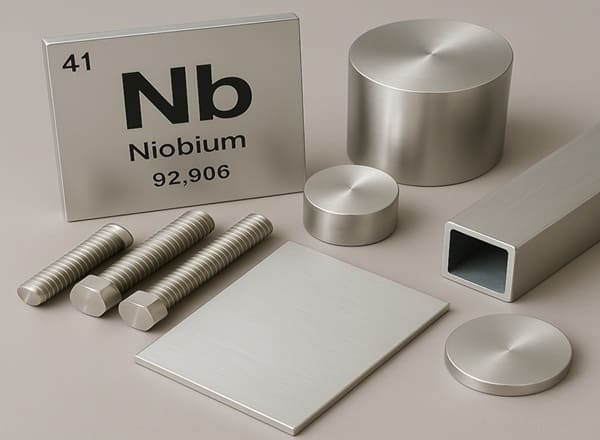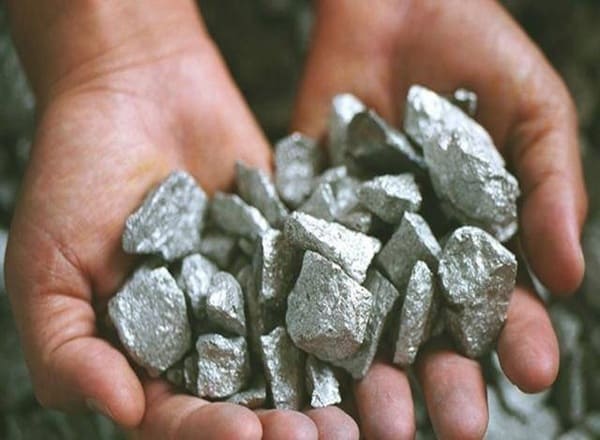Niobium, a rare and versatile metal, has become increasingly vital in modern industrial applications due to its unique properties, such as high melting point, excellent corrosion resistance, and superconductivity. This blog post aims to explore the industry standards that govern the production, testing, and application of niobium and its alloys, ensuring quality, safety, and performance across various sectors.
At Heeger Metal, we specialize in high-quality niobium and niobium alloy products with a variety of forms and specifications, ensuring optimal performance for industrial and scientific applications.

Industry Applications of Niobium and Niobium Alloys
Niobium (Nb), atomic number 41, is a soft, ductile transition metal with a high melting point of approximately 2,468°C. Its chemical stability and resistance to corrosion, particularly in acidic environments, make it a preferred material in demanding applications. Niobium is rarely used in its pure form; instead, it is alloyed with metals like titanium, zirconium, or hafnium to enhance specific properties. Common alloys include niobium-titanium (Nb-Ti), widely used in superconducting applications, and niobium-zirconium (Nb-Zr), valued for its strength and corrosion resistance in chemical processing.
Key Applications:
- Aerospace: Niobium alloys are used in turbine blades and structural components due to their high-temperature strength.
- Energy: Niobium plays a critical role in superconducting magnets for fusion reactors and wind turbines.
- Medical: Niobium’s biocompatibility makes it suitable for surgical implants and MRI equipment.
- Chemical Industry: Niobium’s corrosion resistance is leveraged in reactors and pipelines for handling aggressive chemicals.
The unique properties of niobium, such as its ability to form a stable oxide layer, contribute to its versatility. Industry standards ensure that these properties are consistently achieved, providing guidelines for alloy composition, manufacturing processes, and performance testing.
Looking for high-quality niobium and niobium alloy products? Explore Heeger Materials’ selection.
Key Industry Standards for Niobium and Niobium Aloys
Niobium and niobium alloys, as key materials with high-temperature strength, corrosion resistance, and superconducting properties, have an industry standard system that covers the entire supply chain from basic materials to high-end applications. The following analysis examines international standards, national/regional standards, and industry standards, focusing on key technical indicators and typical application scenarios:
International Standard System
1. ASTM (American Society for Testing and Materials)
- ASTM B393-18: Standard specification for niobium and niobium alloy strip, sheet, and plate. It defines the chemical composition (Nb ≥ 99.9%), mechanical properties (annealed tensile strength ≥ 170 MPa), and dimensional tolerances (tolerance ± 0.013 mm for thickness ≤ 0.15 mm) for five grades (e.g., R04200, R04251).
Application: Electronic device packaging, nuclear reactor shielding. - ASTM B394-20: Standard for seamless tubes, specifying an outer diameter of ≤ 65 mm and a room temperature elongation of ≥ 20%, used for chemical reactor coil tubing.
- ASTM B899-21: Standard for welded tubes, detailing requirements for weld radiographic inspection (ASTM E142) and pressure testing (≥ 1.5 times the working pressure), applicable to aerospace fuel lines.
2. ISO (International Organization for Standardization)
- ISO 5832-12:2019: Standard for tantalum used in surgical implants (Note: niobium alloys in medical applications refer to this standard), specifying biocompatibility testing (ISO 10993) and microstructure requirements (grain size ≤ 50 μm), used for orthopedic implants.
- ISO 18118:2020: General technical conditions for processing materials made from tantalum and tantalum alloys (applicable to niobium alloys), covering hardness (HV ≥ 100) and surface roughness (Ra ≤ 0.8 μm), suitable for chemical equipment linings.
3. EN (European Standards)
- EN 2463:2018: Standard for forged tantalum alloys used in aerospace (relevant for niobium alloys), requiring high-temperature tensile strength (≥ 300 MPa at 700°C) and long-term durability (≥ 100 hours at 700°C/150 MPa), used in rocket engine nozzles.
National/Regional Standards
1. Chinese Standards
- GB/T 14842-2007: Standard for niobium and niobium alloy rods, specifying tensile strength ≥ 207 MPa and elongation ≥ 25% for grades such as Nb1 (Nb ≥ 99.95%) and NbZr1 (Zr = 1.0%), used for nuclear reactor structural components.
- GB/T 8183-2007: Standard for seamless tubes, introducing grades NbZr1 and NbZr2, with an outer diameter range of 1-65 mm, applicable to semiconductor equipment vacuum tubing.
- GB/T 25080-2022: Standard for niobium-titanium alloy rods for superconducting applications, requiring tensile strength ≥ 700 MPa and critical current density ≥ 1×10⁵ A/cm², used in MRI superconducting coils.
- YS/T 656-2015: Standard for grades and chemical compositions, such as Nb1 (Nb ≥ 99.95%) and NbHf10Ti1 (Hf = 10%, Ti = 1%), used for high-temperature alloys.
2. Japanese Standards
- JIS H4600:2021: Standard for tantalum and tantalum alloy processing materials (applicable to niobium alloys), specifying flatness of sheets ≤ 2%, used for semiconductor equipment vacuum chambers.
3. Russian Standards
- GOST 19804-2015: Standard for aerospace-grade tantalum alloys (relevant for niobium alloys), specifying low-temperature impact toughness (≥ 50 J/cm² at -196°C), used for low-temperature pressure vessels.
Industry Standards and Special Specifications
1. Aerospace Industry
- AMS 5566:2020: Standard for tantalum alloy forgings (relevant for niobium alloys), requiring a grain size of ≥5, used for high-temperature components in turbine engines.
- NASA-STD-5013: Welding process specification (relevant for niobium alloys), stipulating an electron beam weld bead width ≤ 0.1 mm, applicable to rocket propulsion systems.
2. Medical Industry
- YY/T 0660-2021: Standard for tantalum used in surgical implants (relevant for niobium alloys), requiring a hemolysis rate ≤ 5% and cell toxicity level ≤ Grade 1, used for artificial joint coatings.
3. Electronics Industry
- EIA-364-81-A: Standard for reliability testing of tantalum capacitors (relevant for niobium alloys), specifying high-temperature life testing (85°C/ rated voltage ≥ 1000 hours), used in consumer electronics.
Comparison of Key Technical Specifications
| Index | ASTM B708 | GB/T 3629 | ISO 5832-12 | Typical Applications |
| Purity (Nb%) | ≥99.9 | ≥99.95 | ≥99.9 | Medical implants |
| Tensile Strength (MPa) | ≥170 | ≥207 | ≥200 | Chemical equipment |
| Elongation (%) | ≥20 | ≥25 | ≥20 | Electronic components |
| Corrosion Resistance (3.5% NaCl) | >1000h | >1000h | >1000h | Marine engineering |
| Biocompatibility | — | — | Meets ISO 10993 standards | Orthopedic implants |
At Heeger Metal, we supply optimized-grade niobium and niobium alloy products that comply with ASTM, ISO, and AMS standards, ensuring outstanding quality and reliability.
Recommendations for Standard Implementation
Material Selection:
- High-pressure environments: Prioritize the use of ASTM B394 seamless tubes, as their wall thickness tolerance is more stringent (±10% vs. ±15% for GB/T 8183).
- Medical implants: Must comply with ISO 5832-12 and provide a biocompatibility testing report.
Process Control:
- Welding processes should refer to NASA-STD-5013, with electron beam welding recommended to minimize the heat-affected zone (width < 0.1 mm).
- Additive manufacturing should follow GB/T 41883 (tantalum alloy standard), and powder must undergo oxygen content testing (≤1000 ppm).
Certification Requirements:
- Exports to Europe must be certified according to EN 2463, and aerospace products must comply with AMS standards.
- Medical devices must pass FDA 510(k) or CE certification, with ISO 10993 testing data provided.
Typical Cases
Aerospace: A certain rocket engine combustion chamber uses NbHf10Ti1 alloy (compliant with AMS 5566), with a service life of 1000 hours at 1650°C.
Medical Field: Porous niobium-coated artificial hip joints (referencing ISO 5832-12), with a bone ingrowth rate > 90%, and no loosening observed in clinical follow-up over 5 years.
Electronics Industry: Niobium capacitors (referencing EIA-364-81-A) used in smartphones, with leakage current ≤ 1μA and a lifespan > 10 years.
Latest Technological Trends
Additive Manufacturing Standards:
GB/T 41883-2022 (tantalum alloy) serves as a reference for 3D printing of niobium alloys, promoting the application of complex structural parts in aerospace.
High-Temperature Alloys:
Nb-Si alloys (such as the 2400°C-grade materials developed by Northwestern Polytechnical University) will increase the operating temperature to 2400°C, suitable for hypersonic vehicles.
Environmental Recycling:
Niobium capacitor recycling mainly follows corporate standards (e.g., niobium content in recycled material ≥ 85%), while international standards are still under development.
Industry standards for niobium and its alloys are essential for ensuring quality, safety, and performance across diverse applications. By setting benchmarks for purity, mechanical properties, and manufacturing processes, these standards enable industries to harness niobium’s unique properties effectively. From aerospace to medical technology, standards bridge the gap between raw materials and high-performance products.
The evolution of standards will be critical to address emerging challenges like sustainability and technological innovation. As industries continue to push the boundaries of niobium applications, updated standards will ensure that this remarkable metal remains a cornerstone of modern technology.
For top-quality niobium and niobium alloy products, Heege Metal provides tailored solutions and precision machining techniques for various applications.
Looking for premium niobium and niobium alloy products? Contact us today!

